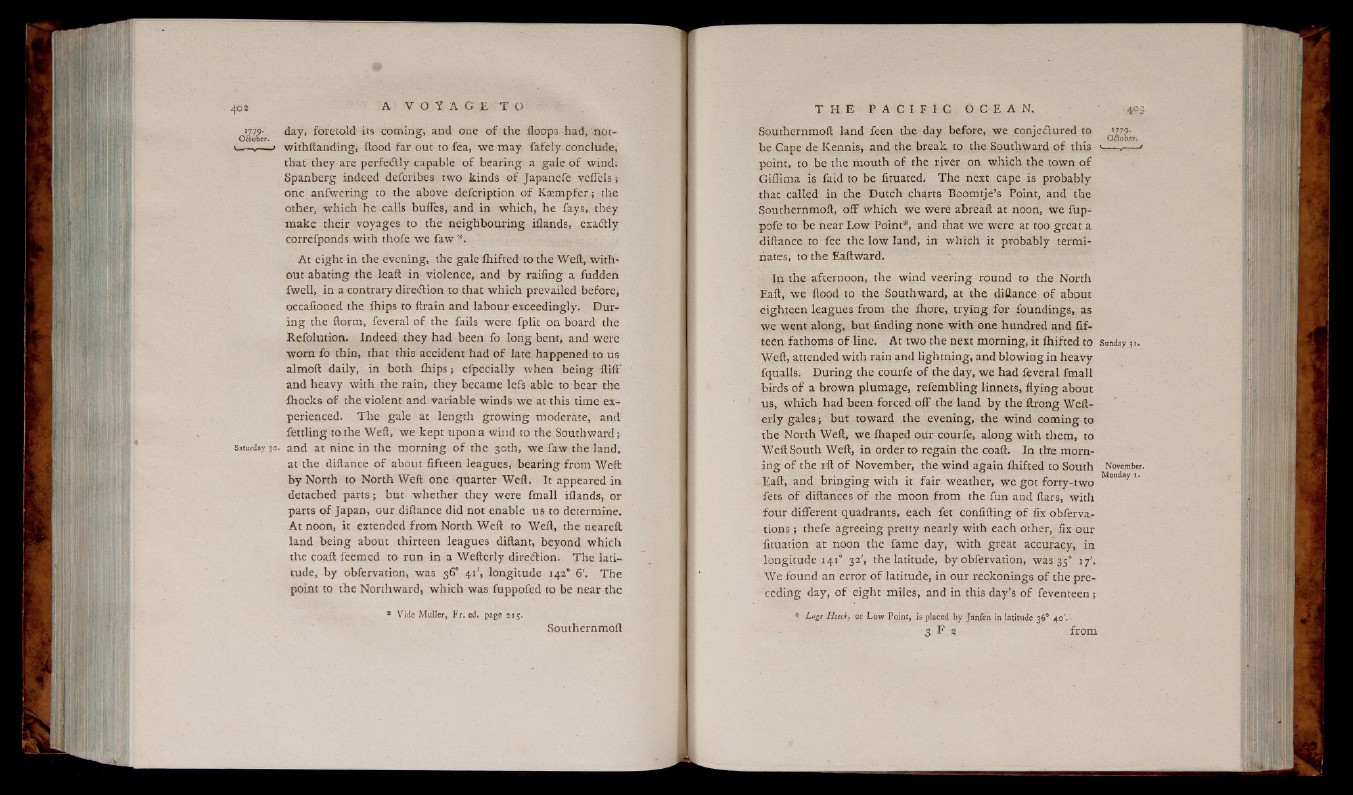
>779’ day, foretold its coining, and one o f the floops had, not-
O & o b e r . y a 1 *
e— .---- 1 withftanding, flood far out to fea, w e may fafely conclude,
that they are perfectly capable o f bearing a gale o f wind.
Spanberg indeed defcribes two kinds o f Japanefe v e fie ls ;
one anfwering to the above defcription o f Ksempfer; the
other, which he calls bufTes, and in which, he fays, they
make their voyages to the neighbouring iilands, exactly
correfponds with thofe we faw *.
At eight in the evening, the gale fhifted to the Weft, without
abating the leaft in violence, and by railing a fudden
fwell, in a contrary direction to that which prevailed before,
occafioned the fhips to ftrain and labour exceedingly. Durin
g the ftorm, feveral o f the fails were fplit on board the
Refolution. Indeed they had been fo long bent, and were
worn fo thin, that this accident had o f late happened to us
almoft daily, in both fh ip s ; efpecially when being ftiff
and heavy with the rain, they became lefs able to bear the
ihocks o f the violent and variable winds we at this time experienced.
T he gale at length growing moderate, and
fettling to the Weft, we kept upon a wind to the Southward;
Sa turda y 30. and at nine in the morning o f the 30th, we faw the land,
at the diftanee o f about fifteen leagues, bearing from Weft
by North to North Weft one quarter Weft, It appeared in
detached parts; but whether they were fmall iilands, or
parts o f Japan, our diftanee did not enable us to determine.
At noon, it extended from North Weft to Weft, the neareft
land being about thirteen leagues diftant, beyond which
the coaft feemed to run in a Wefterly direction. The latitude,
by obfervation, was 36° 41', longitude 142° 6'. The
point to the Northward, which was fuppofed to be near the
* Vide Mullerj Fr, ed. page 215.
Southernmoft
Southernmoft land feen the day before, we conjectured to >779-
October.
be Cape de Kennis, and the break to the Southward o f this s .---- <
point, to be the mouth o f the river on which the town o f
Giflima is faid to be fituated. The next cape is probably
that called in the Dutch charts Boomtje’s Point, and the
Southernmoft, o ff which we were abreaft at noon, we fup-
pofe to be near L ow Point*, and that we were at too great a
diftanee to fee the low land, in which it probably terminates,
to the Eaftward.
In the afternoon, the wind veering round to the North
Eaft, we flood to the Southward, at the diftanee- o f about
eighteen leagues from the fhore, trying for foundings, as
we went along, but finding none with one hundred and fifteen
fathoms o f line. At two the next morning, it fhifted to Sunday &
Weft, attended with rain and lightning, and blowing in heavy
fquajls. During the courfe o f the day, we had feveral fmall
birds o f a brown plumage, refembling linnets, flying about
us, which had been forced o ff the land b y the ftrong Wefterly
g a le s ; but toward the evening, the wind coming to
the North Weft, we fhaped our courfe, along with them, to
Weft South Weft, in order to regain the coaft. In the mornin
g o f the ift o f November, the wind again fhifted to South November.
Eaft, and bringing with it fair weather, we got forty-two Mo”da),
fets o f diftances o f the moon from the fun and ftars, with
four different quadrants, each fet confiding o f fix obferva-
tions ; thefe agreeing pretty nearly with each other, fix our
fituation at noon the fame day, with great accuracy, in
longitude 141° 32', the latitude, by obfervation, was 35° 17'.
We found an error o f latitude, in our reckonings o f the preceding
day, o f eight miles, and in this day’s o f feventeen;
* Lagi Httck, or Low Point, is placed by Janfen in latitude 36° 40'. -
3 F 3 from